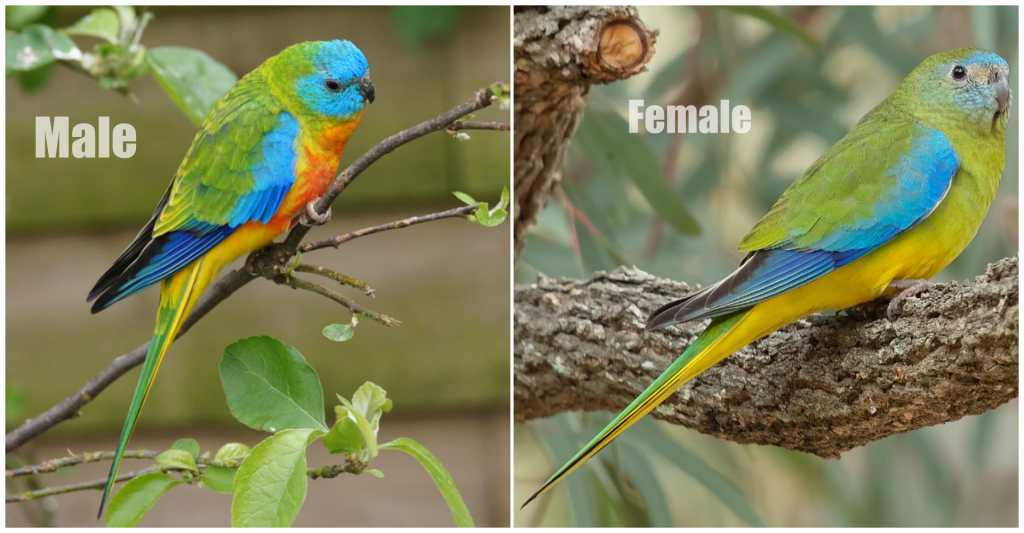Description: Turquoise Parrot (Neophema pulchella) was once widespread as it is today but now occurs only in scattered areas. With their small size, playful nature, and unique characteristics, these charismatic birds make great pets. Although it is uncommon, it is not endangered as long as there are areas in which it can live between woodlands and grasslands.
Closest Species: The scarlet-chested parrot is the closest relative.
Habitats: The turquoise parrot usually lives in pairs or small groups, but flocks of up to 30 can occasionally be seen. Most of the day is spent on the ground, searching for grass seeds and herbaceous plants, or eating vegetable matter. Trees provide shade for them, which is why they prefer to feed there. At first light, the birds usually fly in to drink when they wake up. They drink regularly and daily. A flash of yellow tail feathers appears as they take off and alight as they flutter swiftly through the air. Their wings move sporadically on down-swept wings and they alight and take off quickly. It has been a success for the birds to live in the Warrumbungles National Park in northern New South Wales due to the preservation of its habitat. In the genus Neophema, there are six grass parrot species.

Life Span: It is estimated that Turquoise Parrots have a life expectancy of 10 to 15 years.
Alternative Names: There are various names for the turquoise parrot, including Beautiful Grass Parakeet, Red-shouldered Parakeet, and Turquoisine Parrot.
Size: A turquoise Parrot measures 200 mm in length, including its slender tail.
Food: Grass seeds and shrub seeds are the primary sources of food for turquoise parrots. Flowers, nectar, fruits, leaves, and scale insects are also consumed by them.
Courtship: A courtship is a simple process. His tail is fanned and his wings are opened to show off the blue shoulders, while the male chirps excitedly in front of his mate. Feeding follows the courtship ritual. The male also calls the female out to feed or be fed in the mornings and afternoons while she is brooding. Usually, she goes to a nearby tree to drink before returning to her nest.

Identification: The male upper parts include a crown, bright green. A blue shines on the face. A chestnut-red covert is present on the inner wing; a turquoise covert is present on the lesser and median wings. Dusky flight feathers have dark blue underwing coverts, bends, primary coverts, and outer webs. Flight feathers often have a cream underwing stripe. Throat to crissum bright yellow. The central tail feathers are green, while the outer tail feathers are dull blue with yellow tips. A pale brown eye. Cere and bill are black-grey. Toes and feet are grey-brown.
Female: The female bird’s forehead and face are paler blue; its lores are pale yellow. Green is the color of the front of the neck and breast. There is no chestnut-red on the shoulders. There is an off-white stripe on the underwing.
Immature: The immature is duller than the adult female. The males have a darker blue face and faint chestnut-red patches on their inner wing coverts. The underwing stripe is present. The adult plumage is acquired at about 14 months of age. The downy young is white-downed and yellow-billed.
Talking Abilities: The grass parakeet, for instance, does not have the ability to mimic and talk. Big birds tend to possess that trait more often than not.
Calls: It is often pleasant to hear their natural calls, with soft tweets and chirps that are unique to them. This two-syllable whistle is usually heard in flight by Turquoise Parrots. There is a similarity in the call to that of the Blue-winged Parrot, but it is more subdued. Feeding is accompanied by weak high-pitched twittering.
Nesting & Breeding: Nesting and breeding occur between August and December; sometimes there are two broods per season. There are occasionally green leaves in the nest which are carried in by the female in her rump feathers. The nest is usually a hollow in a dead tree, log, or post; over decayed wood dust. When breeding season approaches, these flocks begin to separate into pairs.
Roosting: It is common for turquoise parrots to roost collectively in autumn and winter. Between 1 and 8 meters above the ground, they roost among the foliage of gums and wattles at night.
Eggs & Incubation: There are two to five or six eggs laid by the bird, which are white and rounded in shape, measuring about 20-22 x 17-18 mm. For females, the incubation period is about 18 days. They fledge after about four weeks and remain with their parents for a few months after that.
Movements: There is no evidence that the turquoise parrot migrates, but its movements are unknown.
Distribution: The Turquoise Parrot is found in the eastern and western scarps of the Great Dividing Range, north to Maryborough and Taroom, Queensland, west to Griffith, New South Wales, and south to Nowra, NSW, and Benalla, Victoria. Mountain slopes, ridges, and watercourses dotted with open forest and timbered grasslands. Turquoise Parrots are somewhat nomadic, and are uncommon.
Races: The races do not exist.
Family: Psittaculidae
Read More – Bluebonnet Parrot – A Majestic Creature That Will Capture Your Heart







